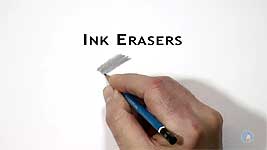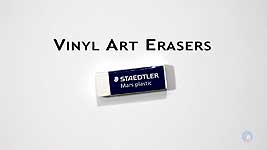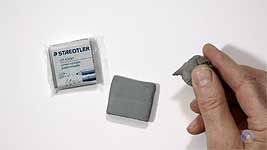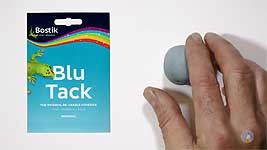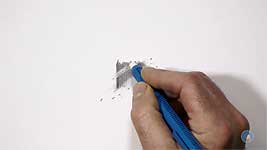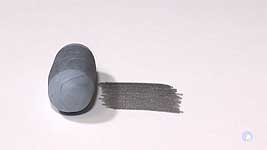Transcript
There are many types of erasers available - or "rubbers" as we call them here in the UK. Of these, some are eminently suitable and others are to be avoided at all cost! I'll begin with those.
INK ERASERS
These were not formulated for the removal of graphite, and they will quite happily remove your paper. Avoid the embarrassment of drilling a hole through it! This is an old typewriter eraser. We go back a long way, as I'll explain. Drilling a hole through your paper? Been there - done that - and this is the culprit. This dog's eye highlight is green-hued because I filled the hole with typewriter correction fluid - but that was many years ago.
GENERAL PENCIL ERASERS
These are less harmful but still best avoided. All rubbers work by - well - rubbing. Rubbing requires pressure, and pressure will inevitably force some graphite deeper into your paper. They're also not very effective, because they can't absorb the graphite, or discard it easily. The crystalline structure of graphite is flat plates - that's why it's shiny. An eraser will pick up the flat plates but, once saturated, it slides those plates over those remaining on the paper. That occurs very readily - because graphite is an excellent dry lubricant. And when the plates slide, they're quite likely to grind others deeper into the paper.
SOFT VINYL ART ERASERS
Now we're entering the realm of suitable erasers - erasers designed to remove graphite. They crumble more easily, to discard the graphite they've removed. However, they cannot tackle heavily applied graphite, and if you attempt to erase a line through an area of graphite, expect a line with soft and smudged edges. The eraser will inevitably drag some graphite along with it.
They come in many forms - mono-style, stick, and block, for example. Many artists use the mono type for creating light hairs - I don't. Hairs have sharp edges, not soft. They are very good though for cleaning up smudges and stray graphite within the drawing and margin. Incidentally, the "click" type - Staedtler, Pentel, and so on - fit a standard pencil sharpener. I usually sharpen mine to a point, or sometimes cut a chisel end.
KNEADED ERASERS
The kneaded eraser is a definite improvement over the others we've looked at. They can remove, and absorb, graphite, and they only need a light rubbing or tapping action, or a simple press down. They can be pinched into sharp edges, or formed into fine points for accurate erasing in tight areas. They're the GO-TO eraser for many artists. They used to be my favourite too - until I purchased a pack that crumbled when I tried to form a point or edge. In desperation, I reached for the wall putty I used to hold my paper onto my drawing board - well, it looked very similar! And that's how I discovered my new favourite - Blu-Tack
BLU-TACK
This is the original, semi-sticky wall putty, designed for holding posters up on walls. It also, unlike all other erasers, needs no pressure or mechanical movement to work. The lightest touch adheres graphite to it, so it removes it cleanly. And, once picked up, Blu-Tack won't redeposit the graphite. This is exactly what we need. The ability to lift graphite right out of the paper's tooth without having to apply any damaging pressure. And if you draw in layers, it also has the ability to adjust the value of the top layer without disturbing the layers beneath, which gives infinite control over values. Of course a kneaded eraser might work for you as well as Blu-Tack does for me - so do try one first. And if you have both and can't tell them apart... a kneaded eraser bounces; Blu-Tack doesn't.
Almost every beginner artist I've worked with (and a few professionals) has had a fear of "drawing too dark", probably in the belief that it's irreversible. You have two tools: a pencil that applies graphite from gentle to aggressive; and an eraser that can gently or aggressively remove graphite. The two compliment each other perfectly. Think of erasing as a means of adjusting values, not of just removing errors, or cutting through existing drawing. If I can show you a way of taking black almost back to white - would that help?
Try this: Fill a small square with 4B - dark and solid. First, let's try a vinyl art eraser. They're quite effective - when the face is clean. Once coated, it slides graphite over graphite, smears, and probably pushes some deeper into the paper.
Now the kneaded eraser. I haven't used one for many years, so you might obtain better results. But it does need a degree of pressure to work. Rubbing has some effect. Tapping has some success too. Pressing and rolling definitely removes graphite.
Now let's try an eraser that requires no pressure at all - my trusty Blu-Tack. Roll a ball into a cylinder. Now gently roll it across your square - no pressure required. Already, you've removed a significant amount of 4B. Now rock and roll, or dab, but be aware that dabbing can create troublesome hard edges. And
don't drag or rub - that just smears. Blu-Tack works because it is slightly sticky, and can pick up and absorb graphite. Persevere. This might take some time - but you will have removed the 4B without damaging your paper. Finally, when you're certain the Blu-Tack cannot remove more, use your vinyl art eraser. But be aware from that point on, you are probably modifying or damaging the tooth of your paper. Remove with Blu-Tack only and you can almost always draw back into that area. Because it doesn't flatten or damage the tooth.
You will need to occasionally clean your kneaded eraser or Blu-Tack. Do that by pulling it into pieces, or a long rope. Fold it back into itself, and then roll it back into a ball. New Blu-Tack might disappoint you. It will work but perhaps no more effectively than a kneaded eraser. Blu-Tack becomes more malleable and improves with age, use, and warmth. I keep a ball warm in my free hand as I draw - so it's softer and slightly stickier. And it lasts... This ball is about three years old.
I know I'm biased, but - use Blu-Tack and never again be afraid of over-darkening and area of your drawing. You can load any area with as much graphite as you desire, because you have the means to remove or adjust it. Remember, blacks and darks are your best friends. They open up a wide choice of greys for you. They increase the three-dimensionality of you work. They add impact and presence to your drawings. And they turn an overcast, grey day, flat, and uninteresting drawing into one with life that dances in bright sunlight.
© copyright: Mike Sibley 2019

